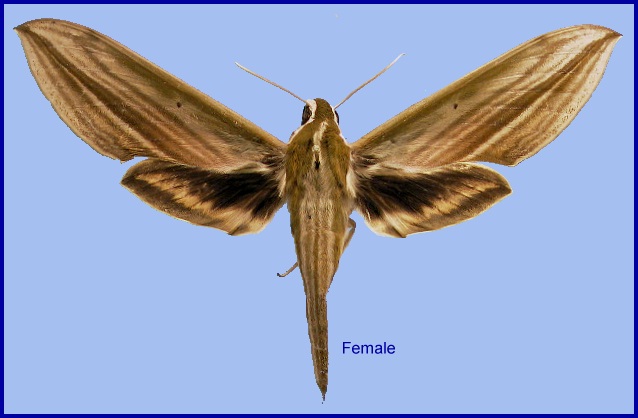
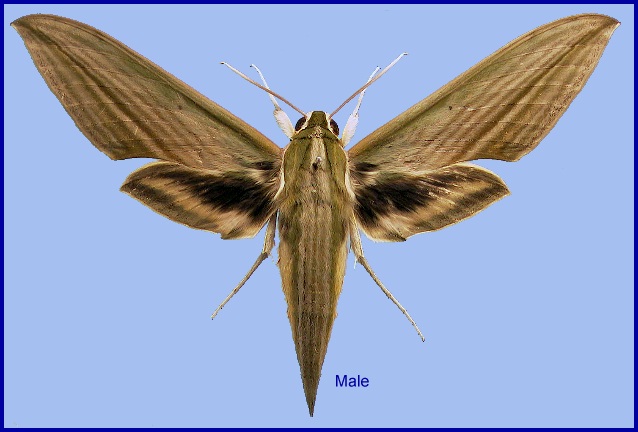
Chaerocampa [sic] lineosa Walker, 1856, List Specimens lepid. Insects Colln Br. Mus. 8: 144. Type locality: [Bangladesh,] Silhet [Sylhet].
Synonym. Chaerocampa lineosa Walker, 1856.
Synonym. Chaerocampa major Butler, 1875.
Synonym. Theretra lineosa Rothschild, 1894.
Synonym. Cechenena lineosa Rothschild & Jordan, 1903.
Wingspan: 74--120mm. A variable species in forewing upperside ground colour and pattern intensity, with some specimens approaching Cechetra scotti and others Cechetra subangustata. Distinguishable from the former by the less intense green band along the costa and from the latter by the orange (not green) tone of the undersides of the wings. Forewing upperside with full complement of seven oblique postmedian lines; lines 3 and 4 the most conspicuous, the other five being narrower and subequal in intensity. There is considerable variation in the brightness of the spaces between the bands (and hence the prominence of the bands). Fresh specimens are decidedly green, fading to brown with age and wear. Forewing underside ground colour orange-beige. Hindwing upperside pale buff median band of variable width, but never heavily suffused with green (as in Cechetra subangustata). Hindwing underside ground colour orange-beige. Head, thorax and abdomen green; a whitish lateral stripe on head and thorax to costa of forewing; thorax with a pale longitudinal dorsal line. Abdomen upperside with spaces between the four dorsal lines paler. Outer midtibial spur as in Cechetra minor.
In the male genitalia, gnathos somewhat more pointed than in Cechetra minor. Harpe simple, not dentate, somewhat spoon-shaped. The large stridulatory scales of the valve almost symmetrical, not heavily folded. Phallus asymmetrical, the right process slender, with few teeth; the left broader, tongue-shaped, dentate at the edges.
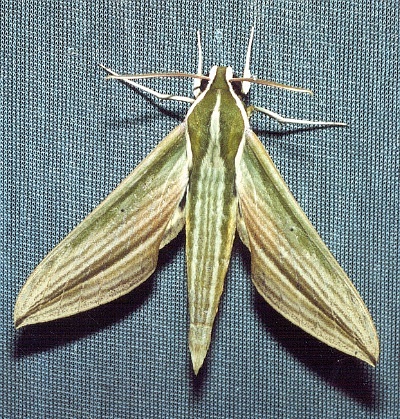
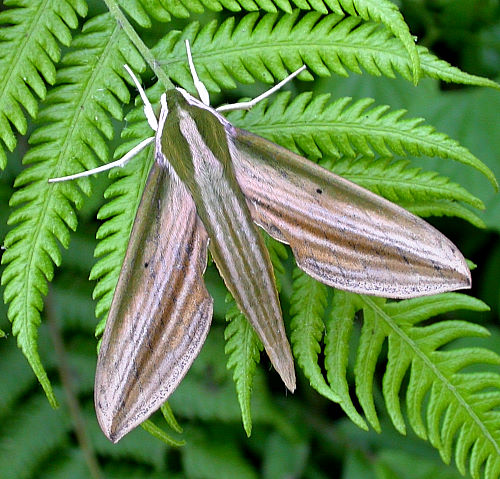
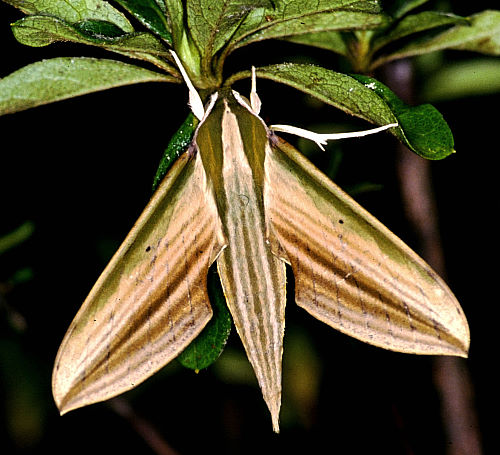
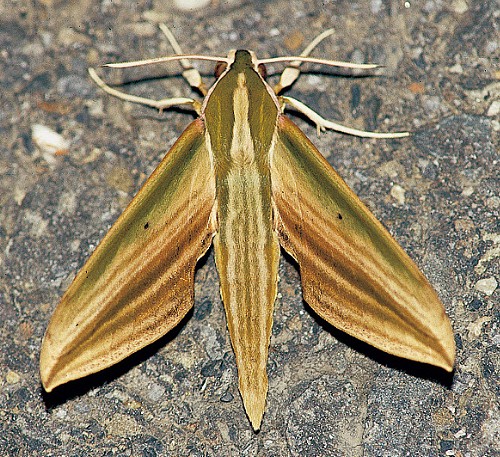
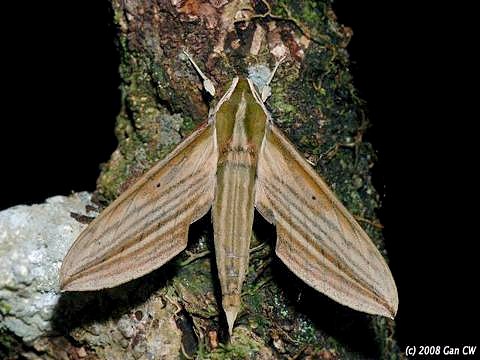
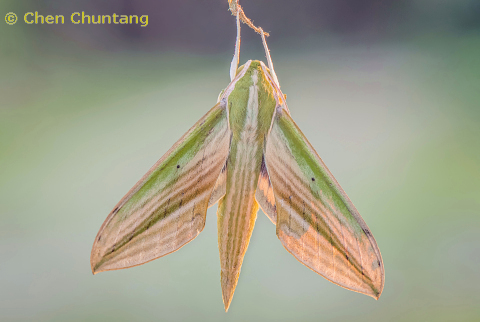
Habits similar to those of Theretra and Rhagastis. The moth is swift on the wing visits flowers after dusk, as well as being attracted by light (Bell & Scott, 1937).
China: 13.iii (Yunnan); v-vi (Yunnan; Guangdong); vi (Zhejiang); 20-30.vii (Yunnan); viii (Zhejiang). Taiwan: iii-xi (Hualien Hsien); iii-v (Kaohsiung Hsien); v (Taichung Hsien).
OVUM: Pale ivory, broadly ovoid, surface smooth and shiny (Bell & Scott, 1937).
LARVA: Full-fed 100mm; width 12mm; horn 8 mm. In the first instar, honey-yellow with a long, straight black horn. In the second instar the head remains yellow. The body becomes green, long and thin, with segments 4 and 6 tumid; surface shiny. Horn brown turning black towards the tip, which is white. By the third instar, head and body (except segment 6) green; segment 6 very swollen, crimson, ocellus with a green pupil edged with first white, then black. Claspers and venter pale crimson; horn purple. In the fourth instar the head is green. The body, except for segment 5 and the claspers, has become a curious shade of yellowish-green, with a narrow dorsal stripe running from segment 2 to base of horn. There is also a dorso-lateral stripe on 2 to 4 and oblique lateral stripes on segments 6 to 10, all brick red. The dorso-lateral stripe sometimes continues to base of horn as a series of dots. Segment 5 and claspers crimson, ocellus with pupil blue in front, reddish dotted with yellow behind, the whole edged with first white and then black. Surface of body and horn smooth and dull. Horn long, thick at base, tapering gently to a point, flattened laterally, yellow speckled closely with black (Bell & Scott, 1937).
In the final instar, head dull and smooth. Body also dull and smooth except for the ocelli, which are shiny as though enamelled. Segment 5 much swollen, and both 4 and 5 somewhat dilated ventro-laterally. Horn of medium length; when seen in side-view first increasing in depth, then decreasing, distal third tapering very slightly to a blunt tip. In dorsal view, the horn is laterally flattened, first increasing in breadth, then decreasing, then again increasing to form a slightly bulbous tip; basal third rising at an angle of about 45° to the body, distal two-thirds then bent sharply downwards, or the horn down-curved throughout its length. The dorsal and ventral surfaces of the horn covered with small rounded tubercles, and the sides longitudinally grooved.
In colour, head brown with a darker stripe separating face from cheek. Body brown or reddish-brown above the dorso-lateral stripe, with numerous short dark stripes across the secondary rings; reddish with darker spots below the dorso-lateral stripe. Latter pink or reddish edged above with dark brown, from 2 to base of horn, broken by the ocellus on 5 and waved dorsally on each segment a narrow pale subspiracular stripe on 2 to 4. Eye-spot on 5 obliquely oval, pupil dark brown dotted with minute white dots in front half and with large yellow dots in posterior half, the whole edged with bright blue in front, yellow behind and then narrowly with dark brown. A round whitish subdorsal spot is present in the posterior half of each of segments 6 to 11 and the spiracles on the same segments are surrounded by an ochreous patch bounded in front by the dark brown oblique stripes on 5 to 10. Horn dark brown. Spiracles dark brown edged with ochreous (Bell & Scott, 1937).
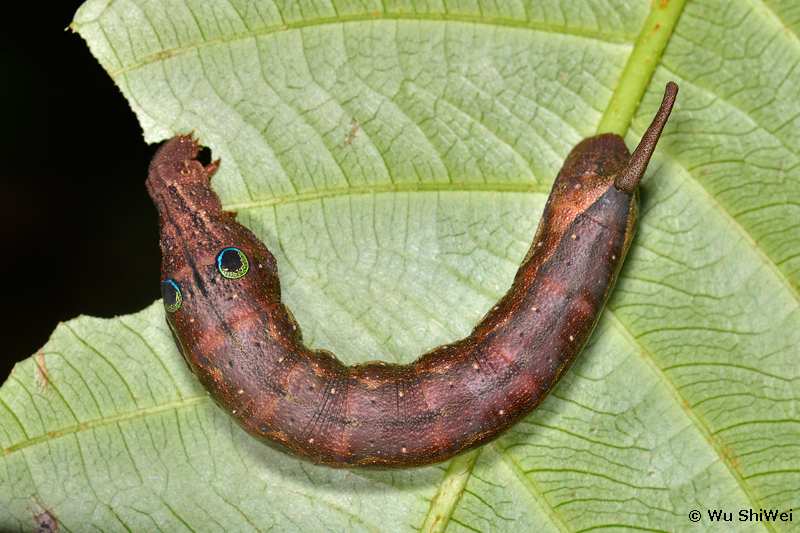
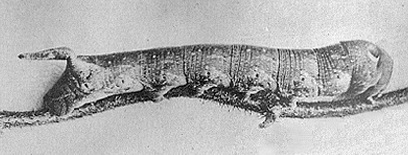
PUPA: 70mm; breadth 12 mm. Head, thorax, tongue-case and wing-cases very dark brown, head and thorax with paler patches on dorsum; venter brownish-pink. The tubercles on tongue-case, legs and veins black; abdomen pale brownish pink with short, dark brown lines forming dorsal, lateral and ventral stripes. Bevels of free abdominal segments darker; spiracles and cremaster black. Tongue-case much projecting frontad, in side view shaped like a duck's bill seen from above; the frons rises sharply from the base of the tongue-case to a transverse ridge running from eye to eye. Surface of head, tongue-case, thorax and wing-case coarsely shagreened. Edge of tongue-case, legs and veins set with pointed tubercles; abdomen finely shagreened. Cremaster triangular, tip truncate, a long straight spine directed backwards at each lateral angle of the truncation, and a straight, equally long spine directed outwards from its base. With two dorso-lateral spines near the tip, the proximal one ending in two hooks; all the spines and hooks polished and shiny (Bell & Scott, 1937).

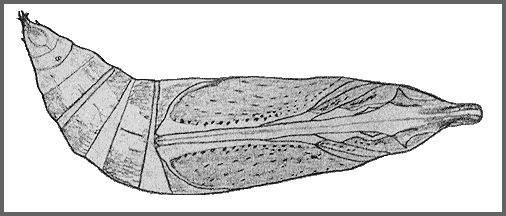
Larval hostplants. Saurauia tristyla, Impatiens, Vitis and Polygonum in India (Bell & Scott, 1937).
China: Shaanxi (Zhuque National Forest Park, Qinling; Taibai Shan, Qinling; Huayangzhen, Qinling; Feng County, Qinling); Henan (Huamei Valley Scenic Area); Anhui (Mt. Huang Shan); Zhejiang (Lüsi; Tianmu Shan; Tianmushanzhen; Kuocang Mountain Nature Reserve; Longquan, Lishui; Wanghaigang; Yuyao; Daming Shan); Hubei (Lichuan; Hefeng; Luotian; Jiuhuring); Sichuan (Kangding; Wolong National Nature Reserve; Pengshui; Huili; Xiaolou; Luojiagou; Ya'an; Leshan; Wawu Mountain Forest Park; Fulaicun); Yunnan (Kunming; Changning County, Songzhishanding, 2800m; nr. Yingjiang, 1180-2080m; Mengla County, Mt. Leigongyan, 2000m; Gaoligong Shan; Malipo County, Wenshan Zhuang and Miao Autonomous Prefecture, 1860m; Yangbi Yi Autonomous County, Dali; Yanjiao; Phan Xi Pang; Dawei Shan); south Xizang/Tibet (Mutu, Namjagbarwa region, 850m (Wang, 1988); Zhangmu, 2200m; Yi'ong, 2700m; Yadong, 2900m); Guizhou (Qiannan Buyei and Miao Autonomous Prefecture; Qiandongnan Miao and Dong Autonomous Prefecture); Hunan (Sangzhi, Zhangjiajie; Daoxian, Yongzhou); Jiangxi (Tiancun, nr. Xingguo; Jiulianshan National Forest Park; Nanchang); Fujian (Sanming; Nanping); Guangdong (Nanling National Forest Park, 1100m (Morishita & Kishida, 2000); Ruyuan, Shaoguan); Guangxi (Damingshan Scenic Area); Hainan (Duowen Ling, nr. Lingao; Zhiqing Forest; Ledong Li Autonomous County).
Taiwan: Hualien Hsien (Taroko National Park); Kaohsiung Hsien (Shanping, 640m); Taoyuan Hsien (Baling); Taichung Hsien (Piluchi, 2200m); Taipei Hsien (Fushan; Sindian); Hsinchu Hsien (Jianshi Xiang, 899m); Tainan City (Nanhua District, 638m); Pingtung Hsien; Taitung Hsien; Nantou Hsien (Qinglong Falls; Lushan Spa; Houfuanshan); Miaoli Hsien; Yilan Hsien; Yulin Hsien; Chiayi Hsien (Alishan).
Northern India (Subhasish Arandhara, 2016; Khan & Raina, 2017; Jatishwor Irungbam & Fric, 2021), Nepal, Bhutan (Irungbam & Irungbam, 2019), Bangladesh, Burma/Myanmar, Thailand, southern China (Morishita & Kishida, 2000), Taiwan, Vietnam (Le & Vu, 2024), Malaysia (Peninsular, Sarawak, Sabah), Indonesia (Sumatra, Java, Kalimantan, Sulawesi).
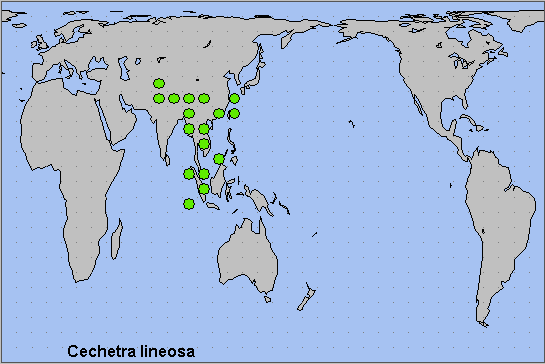
 Return to Sphingidae of the Eastern Palaearctic species list
Return to Sphingidae of the Eastern Palaearctic species list